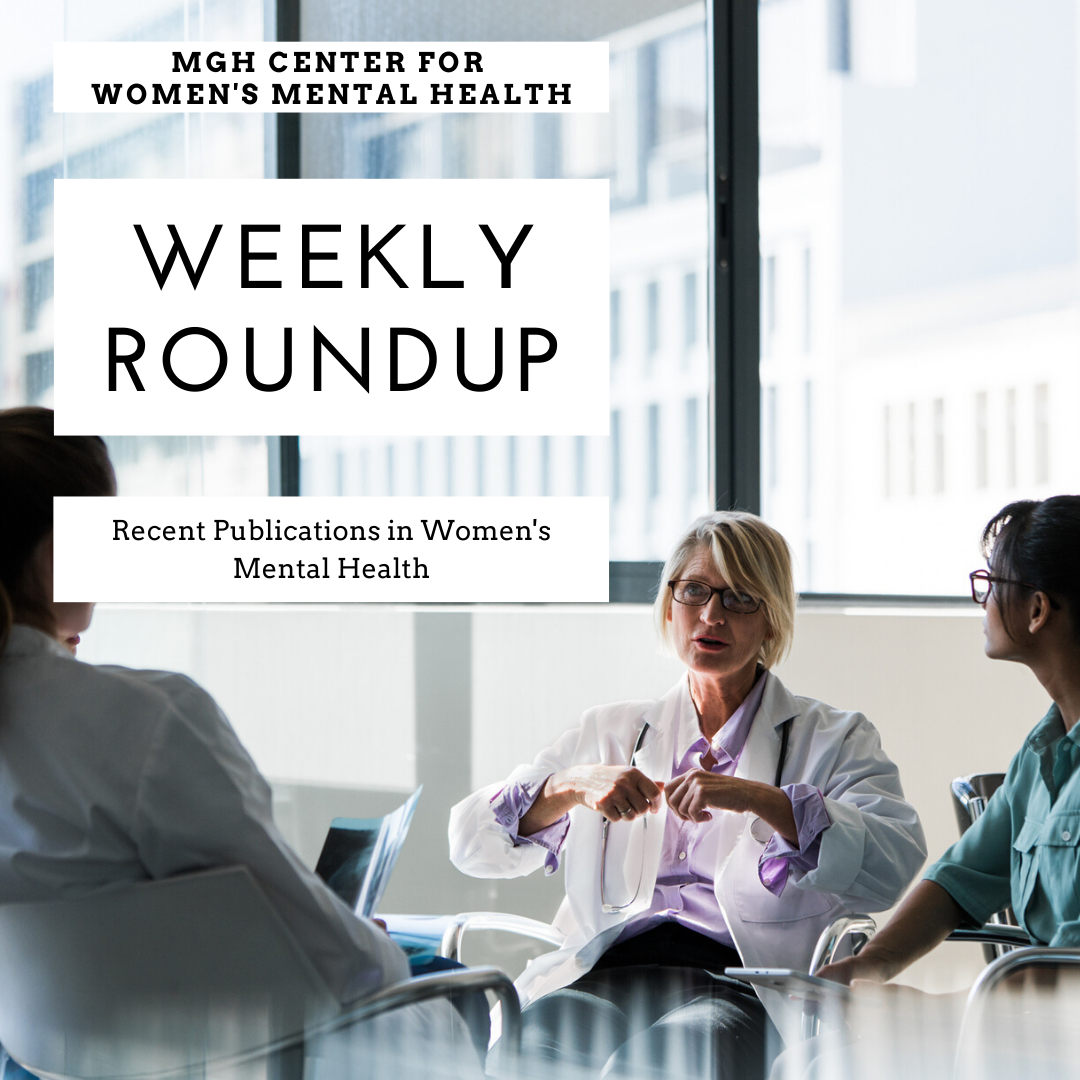
Every week we review the most recent publications in women’s mental health, covering topics related to premenstrual symptoms, perinatal mood and anxiety disorders, use of medications in pregnant and breastfeeding women, perinatal substance use, and menopausal mental health.
For more detailed descriptions of many of these topics, you can sign up to receive our weekly CWMH NEWSLETTER which comes out every Thursday.
And don’t forget to visit ESSENTIAL READS – a curated selection of up-to-date and clinically relevant articles in women’s mental health.
Ruta Nonacs, MD PhD
PMS AND PMDD |
| No articles this week
|
INFERTILITY AND MENTAL HEALTH |
| Impact of duloxetine on male fertility: A randomised controlled clinical trial.
Punjani N, Kang C, Flannigan R, Bach P, Altemus M, Kocsis JH, Wu A, Pierce H, Schlegel PN. Andrologia. 2021 Nov;53(10):e14207. Duloxetine at 60 mg was not associated with any changes in sperm quality. READ MORE on our website.
|
PSYCHIATRIC ILLNESS DURING PREGNANCY |
| Perinatal depression screening using smartphone technology: Exploring uptake, engagement and future directions for the MGH Perinatal Depression Scale (MGHPDS).
Vanderkruik R, Raffi E, Freeman MP, Wales R, Cohen L. PLoS One. 2021 Sep 29;16(9):e0257065. Free article. Using the MGH Perinatal Depression Scale (MGHPDS), cross-sectional mental health data was collected from over 700 women during the perinatal period, including women across over 30 countries. Over half of the women during pregnancy and over 70% of women in the postpartum had a depression score indicative of clinical depression.
Prenatal stress and offspring depression in adulthood: The mediating role of childhood trauma. Liu Y, Heron J, Hickman M, Zammit S, Wolke D. J Affect Disord. 2021 Oct 17;297:45-52. Both antenatal and postpartum maternal depression and family adversity were associated with increased risk for depression in the offspring at 24 years of age in simple logistic regression models. However, when all pathways were modelled simultaneously, only childhood trauma (in the mother) was directly associated with offspring depression, and mediated all pathways from antenatal and postpartum stress to offspring depression (7-16% of the total effect mediated).
Wenzel ES, Eisenlohr-Moul T, Nagelli U, Bernabé BP, Maki PM. Arch Womens Ment Health. 2021 Oct 26. Potential threat may be a prominent, transdiagnostic feature of perinatal anxiety and depression, whereas reward valuation may be a non-transdiagnostic, weaker feature of perinatal depression. Potential threat is important as both a “trait-like” feature that is sustained across the perinatal period and a “state-like” feature that varies within a woman across pregnancy. Depression and socioeconomic stressors in expectant parents with fetal congenital anomalies. Kim AJH, Servino L, Bircher S, Feist C, Rdesinski RE, Dukhovny S, Shaffer BL, Saxton SN. J Matern Fetal Neonatal Med. 2021 Oct 20:1-7. In expectant parents diagnosed with a fetal anomaly, 21.7% of pregnant subjects and 25.0% of co-parents had a positive screen on the EPDS during their pregnancy. Mothers’ EPDS scores correlated with the severity of the fetal anomaly. Many parents reported socioeconomic stressors including: living remotely from the medical center, low household income, food insecurity, unemployment, or other employment concerns, and difficulty affording living expenses. Most also reported factors that can mitigate psychological distress including social support and participation in a religion or faith.
|
MEDICATIONS AND PREGNANCY |
| The effect of prenatal lithium exposure on the neuropsychological development of the child.
Poels EMP, Schrijver L, White TJH, Roza SJ, Zarchev MG, Bijma H, Honig A, van Kamp IL, Hoogendijk WJG, Kamperman AM, Bergink V. Bipolar Disord. 2021 Sep 29. READ MORE on our website.
|
POSTPARTUM PSYCHIATRIC ILLNESS |
| Postpartum depression screening: Treatment engagement, barriers to care, and change in depressive symptoms.
Vanderkruik R, Freeman MP, Claypoole LD, Arakelian M, Kaimal AJ, Nadel H, Cohen LS. Ann Clin Psychiatry. 2021 Nov;33(4):e2-e9. A total of 33 women participated in the study, out of 100 who scored ?12 on the EPDS. Among the participants, 70% reported they received a referral to a health care provider for PPD, and nearly one-half said that they received psychotherapy and/or were prescribed a psychotropic. The 2 most commonly described barriers to treatment were perceptions of not needing or wanting help and concerns about breastfeeding while taking psychotropics.
Thyroid function in postpartum psychosis: An exploratory study. Sethy RR, Garg S, Ram D, Tikka SK. Asia Pac Psychiatry. 2021 Jun;13(2):e12465. Isolated increase in free T4 and thyroid lobe volumetric changes could be more specifically associated with psychosis of postpartum onset.
Schuster ALR, Perraillon MC, Paul JJ, Leiferman JA, Battaglia C, Morrato EH. Med Care. 2021 Oct 19. Before the Affordable Care Act (ACA), most women who gained pregnancy-related Medicaid insurance were not eligible for Medicaid during the postpartum period. The ACA aimed to expand health insurance coverage, in part, by expanding Medicaid. In 5 states where the ACA expanded Medicaid coverage, the ACA’s provisions were associated with large increases in retention of postpartum insurance and reductions in postpartum depressive symptoms.
Mapping global prevalence of depression among postpartum women. Wang Z, Liu J, Shuai H, Cai Z, Fu X, Liu Y, Xiao X, Zhang W, Krabbendam E, Liu S, Liu Z, Li Z, Yang BX. Transl Psychiatry. 2021 Oct 20;11(1):543. Free article. Varied prevalence rates were noted in geographic regions with the highest rate of PPD found in Southern Africa (39.96%). Of interest was a significantly lower rate of PPD in developed countries or high-income countries or areas. Furthermore, the findings showed that there was a substantial difference in rates of PPD when marital status, educational level, social support, spouse care, violence, gestational age, breast feeding, child mortality, pregnancy plan, financial difficulties, partnership, life stress, smoking, alcohol intake, and living conditions were considered in the pooled estimates. The results of this study indicated that one out of every five women experiences PPD which is linked to income and geographic development.
|
MEDICATIONS AND BREASTFEEDING |
| Breastfeeding practices among women taking second-generation antipsychotics: findings from the National Pregnancy Registry for Atypical Antipsychotics.
Viguera AC, Vanderkruik R, Gaccione P, Caplin PS, Kobylski LA, Freeman MP, Cohen LS. Arch Womens Ment Health. 2021 Jul 28. Rates of breastfeeding initiation and continuation were higher among participants who did not use SGAs. Among women not on SGAs, 88.2% of women reported “ever breastfeeding” compared to 59.3% of women on an SGA. At 3 months postpartum, 47% of women on a non-SGA were exclusively breastfeeding compared to 23% of women on an SGA. While the majority of women on an SGA initiated breastfeeding, breastfeeding rates were considerably lower than for women who were not on a SGA.
|
PERINATAL SUBSTANCE USE |
| Low barrier perinatal psychiatric care for patients with substance use disorder: meeting patients across the perinatal continuum where they are.
Raffi ER, Gray J, Conteh N, Kane M, Cohen LS, Schiff DM. Int Rev Psychiatry. 2021 Sep;33(6):543-552.
|
MATERNAL MENTAL HEALTH AND CHILD OUTCOMES |
| No articles this week
|
MENOPAUSE AND MENTAL HEALTH |
| The short-term effects of estradiol, raloxifene, and a phytoestrogen in women with perimenopausal depression.
Schmidt PJ, Wei SM, Martinez PE, Dor RRB, Guerrieri GM, Palladino PP, Harsh VL, Li HJ, Wakim P, Nieman LK, Rubinow DR. Menopause. 2021 Jan 15;28(4):369-383.
|
OTHER TOPICS IN WOMEN’S MENTAL HEALTH |
| No articles this week |



Leave A Comment